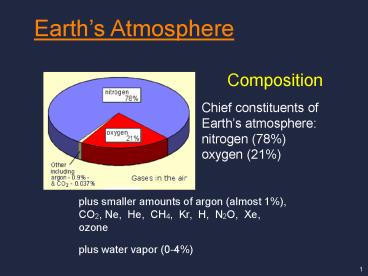Composition
1 / 23
Title: Composition
1
Earths Atmosphere
Composition
Chief constituents of Earths atmosphere nitrogen
(78) oxygen (21)
plus smaller amounts of argon (almost 1), CO2,
Ne, He, CH4, Kr, H, N2O, Xe, ozone
plus water vapor (0-4)
2
Layers of the Atmosphere
Home of the ozone layer a concentration of
ozone molecules (just a few parts per million).
Stratosphere
the tropopause
Troposphere
Where humans live home of all weather.
Contains 80 of atmospheres mass (i.e., air
molecules).
Temperature drops 3.5F per 1000 of elevation
gain. When its 30F and snowing on Mt.
Hamilton (4209), its 44F and drizzling in
downtown San José (100).
3
The composition of solar radiation
2 ultraviolet (UV)
49 visible
49 infrared (IR)
4
Solar radiation energizes Earth, which also
radiates.
Insolation is an example of a portmanteau.
Insolation
Incoming solar radiation
49 infrared 49 visible 2 ultraviolet
Some insolation is reflected by Earths surface
or atmosphere the rest passes through the
atmosphere to strike Earths surfaceimparting
energy to Earth.
5
Fortunately for humans and all life on Earth,
most shortwave radiation is absorbed or reflected
in Earths atmosphere.
6
Earth radiates its energy as infrared radiation.
Incoming solar radiation (insolation)
Earth radiates strictly at infrared wavelengths
(remember that the Sun radiates at visible and UV
wavelengths, too).
Earth radiates 100 infrared
Most atmospheric gas molecules are oblivious to
the longer-wavelength radiation from Earth, just
as they are to solar radiation. However,
molecules of certain gasescalled greenhouse
gasesabsorb part of Earths infrared radiation.
7
If Earth emitted exactly as much energy as it
absorbs from the Sun (physicists call such an
object a blackbody), its equilibrium T would be
-18C (255 K) 0 F
8
But the average T of Earths surface is 15 C
(278 K) 59 F.
Why?
So the greenhouse effect is a good thing. It
makes Earths surface warm enough for life.
9
The Greenhouse Effect
1. Insolation absorbed by Earths surface.
2. Earth emits infrared radiation.
3. Greenhouse gases absorb some of Earths
infrared radiation.
4. Greenhouse gases emit infrared radiation in
all directions.
5. Earth absorbs downward-directed infrared
radiation.
Result Warmer troposphere
10
reaches
emits
The Sun
The Earth
solar radiation
emits
visible
infrared
ultraviolet
Infrared radiation
water vapor, CO2, CH4, N2O, ozone
is selectively absorbed by
such as
Greenhouse gas molecules
subsequently have
More kinetic energy
causes
More collisions of gas molecules in the
atmosphere
cause
Increased temperature of the atmosphere
11
Lets consider the fate of insolation
12
Albedo
Earths overall albedo 0.30 30
Fresh snow Thick clouds Thin clouds Ice Water Gras
s Dirt Forest
0.750.95 0.60.9 0.30.5 0.30.4 0.1 0.10.3 0.1
0.2 0.030.1
7590 6090 3050 3040 10 1030 1020 310
13
The amount and distribution of energy in the
Earth system, and thus Earths climate, depend on
three variables
1) The amount of incoming solar radiation.
depends on Suns output
2) The fraction of solar radiation that is
reflected (albedo).
depends on Earths albedo
3) The amount of Earths infrared radiation that
escapes to space.
depends on composition of Earths atmosphere
(GHGs)
These factors balance to produce stable climate
conditions.
14
Earths Energy Balances
342
107 235
Energy entering top of atmosphere
Energy leaving top of atmosphere
Energy gained by atmosphere
Energy lost by atmosphere
165 324 30
67 350 78 24
Energy entering Earths surface
Energy leaving Earths surface
168 324
24 78 390
15
The energy balance at Earths surface.
incoming
outgoing
Earths surface
What if all greenhouse gases were removed from
the atmosphere?
16
(No Transcript)
17
Problem
Start with current conditions (Earths surface
temperature 15C atmosphere w/greenhouse gases.
final T ??
18
Lets compare Earth to Venus.
19
Based solely on proximity to the sun, which
planet will be warmer?
Venus
Earth
Venus
23
20
However
If insolation 100 units, 100 x 0.7 70
units are absorbed by Earth.
In these units, 193 x 0.3 58 units are absorbed
by Venus.
21
So. If a planets surface temperature depended
solely on the rate at which it absorbs solar
radiation, Venus would be ______ than Earth.
cooler
However
480
astrology.com Venus is all about pleasure.we
appear attractive thanks to Venus energy.beauty
is also strongly associated with
Venus.inextricably linked to refinement,
culture, charm and grace
22
The reason Different atmospheres
runaway greenhouse effect
23
Earths Climate System The Major Players
Three Overarching Variables (ECS B2, B3) 1) the
amount of incoming solar radiation 2) the
fraction of solar radiation that is reflected
(albedo) 3) the amount of Earths IR radiation
that escapes to space
Regional Controls of Climate (ECS C1)
Altitude, latitude, mountains, proximity to
oceans (geography) Axial tilt Pressure
systems
Global Factors That Affect Climate (ECS C2 ff.)
External and internal factors Factors that
humans can and cannot influence

